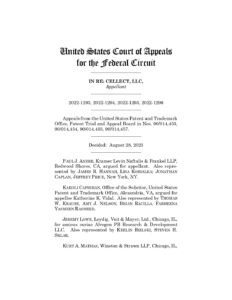By Glen K. Thurston, Ph.D.
For over a century, under the judicial doctrine of obviousness-type double patenting (ODP), courts have precluded patentees from obtaining more than one patent on substantially the same invention. Terminal disclaimers can resolve ODP by uniting the duplicative patents as one—i.e., the patents maintain common ownership and expire at the earlier of the two expiration dates.
Because a patent term is for 20 years from the time of filing, delays by the Patent Office could unduly shorten the effective term of a patent after issuance. Therefore, the Patent Office grants patent term adjustments (PTA) to compensate for such delays. Furthermore, the Patent Office grants patent term extension (PTE) to compensate for delays in regulatory approval. Importantly, PTE is calculated from the date of the terminal disclaimer.
In In re: Cellect, LLC, No. 22-1293 (Fed. Cir. 2023), the Federal Circuit considered as a matter of first impression how ODP, terminal disclaimers and PTA are related. Of the four admittedly duplicative patents in question, only one had not been awarded PTA. That patent thus expired 20 years after its effective filing date and before the remaining three patents that received PTA. Ordinarily, Cellect could file a terminal disclaimer to resolve the ODP. However, the filing of a terminal disclaimer is not allowed when the earlier patent has already expired.
Cellect unsuccessfully argued that PTA should be treated like PTE, i.e., that PTA should be calculated from the date of the disclaimer. Rather, the Court agreed with the USPTO that “PTA and PTE should be treated differently when determining whether or not claims are unpatentable under ODP.” Id. at 15. “We thus conclude that ODP for a patent that has received PTA, regardless whether or not a terminal disclaimer is required or has been filed, must be based on the expiration date of the patent after PTA has been added.”
In this case, the patent that had not been awarded PTA expired on October 6, 2017. Because of the ODP, the other three patents should also expire no later than October 6, 2017, despite the awarded PTA.
Also at issue in Cellect was a contention that “the use of ODP to invalidate related patents with shared expiration dates based on an alleged nonexistent risk of divided ownership is improper.” Id. at 21. The Court again sided with the USPTO, saying that “the patents expired fewer than six years ago, so the risk remains for multiple assignees to seek past damages.” Id. at 22–23. Cellect argued that it acted in good faith, and because the calculation of how much PTA is awarded accounts for actions on the part of the applicant that delay issuance of the patent, Cellect should not lose out on the PTA awarded. In reply, the Court stated that “[a]n applicant’s ability to show that it did not engage in gamesmanship in obtaining a grant of PTA is not sufficient to overcome a finding that it has received an unjust timewise extension of term.” Id. at 23.
We note that Jeremy Lowe, Steven H. Sklar, and Keelin Bielski represented amicus curiae Alvogen PB Research & Development LLC and submitted a brief in this case.


